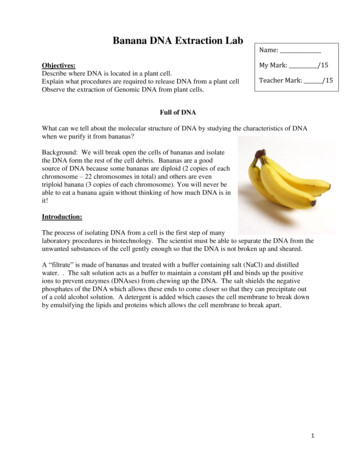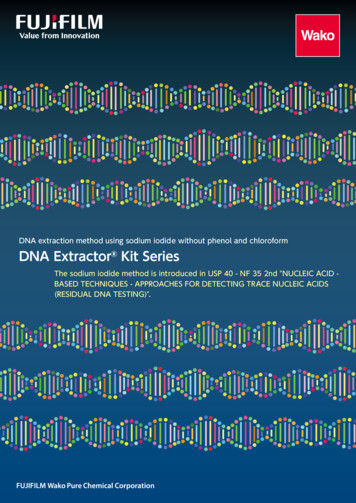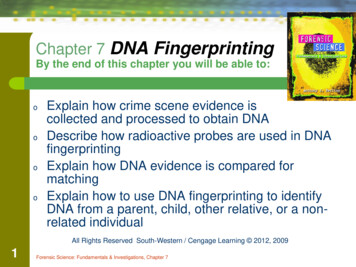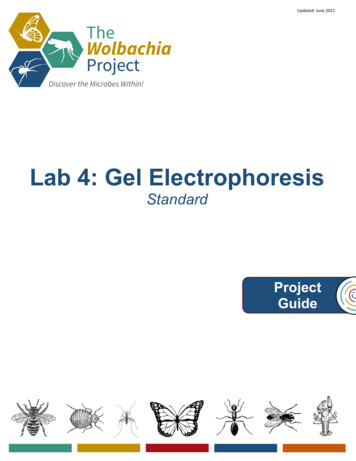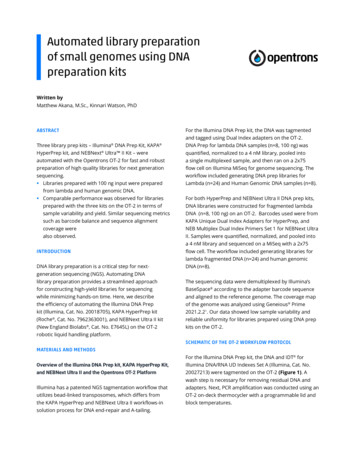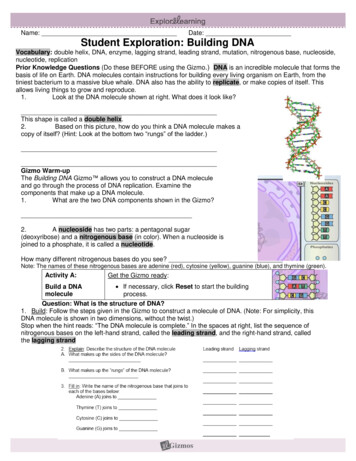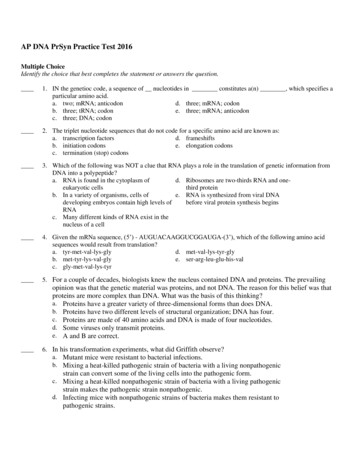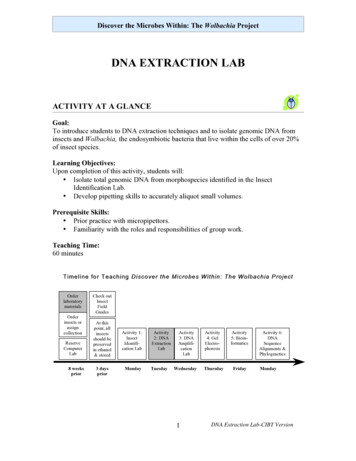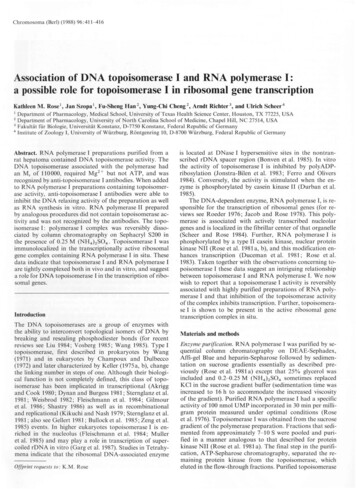
Transcription
Chromosoma (Berl) (1988) 96 :411-416Association of DNA topoisomerase I and RNA polymerase I:a possible role for topoisomerase I in ribosomal gene transcriptionKathleen M . Rose 1, J an Szopa 1, Fu-Sheng Han 2, Yung-Chi Cheng 2, Arndt Richter \ and Ulrich Scheer 4I234Department of Pharmacology, Medical School, University of Texas Health Science Center, Houston, TX 77225, USADepartment of Pharmacology, University of North Carolina School of Medicine, Chapel Hill, NC 27514, USAFakultiit fUr Biologie, Universitiit Konstanz, 0-7750 Konstanz, Federal Republic of GermanyInstitute of Zoology I, University of Wiirzburg, Rontgenring 10, 0-8700 Wiirzburg, Federal Republic of GermanyAbstract. RNA polymerase I preparations purified from arat hepatoma contained DNA topoisomerase activity. TheDNA topoisomerase associated with the polymerase hadan Mr of 110000, required Mg2 but not ATP, and wasrecognized by anti-topoisomerase I antibodies. When addedto RNA polymerase I preparations containing topoisomerase activity, anti-topoisomerase I antibodies were able toinhibit the DNA relaxing activity of the preparation as wellas RNA synthesis in vitro. RNA polymerase II preparedby analogous procedures did not contain topoisomerase activity and was not recognized by the antibodies. The topoisomerase I: polymerase I complex was reversibly dissociated by column chromatography on Sephacryl S200 inthe presence of 0.25 M (NH 4hS04. Topoisomerase I wasimmunolocalized in the transcriptionally active ribosomalgene complex containing RNA polymerase I in situ. Thesedata indicate that topoisomerase I and RNA polymerase Iare tightly complexed both in vivo and in vitro, and suggesta role for DNA topoisomerase I in the transcription of ribosomal genes.IntroductionThe DNA topoisomerases are a group of enzymes withthe ability to interconvert topological isomers of DNA bybreaking and resealing phosphodiester bonds (for recentreviews see Liu 1984 ; Vosberg 1985 ; Wang 1985). Type Itopoisomerase, first described in prokaryotes by Wang(1971) and in eukaryotes by Champoux and Dulbecco(1972) and later characterized by Keller (1975a, b), changethe linking number in steps of one. Although their biological function is not completely defined , this class of topoisomerase has been implicated in transcriptional (Akriggand Cook 1980; Dynan and Burgess 1981; Sternglanz et al.1981; Weisbrod 1982; Fleischmann et al. 1984 ; Gilmouret al. 1986; Shastry 1986) as well as in recombinationaland replicational (Kikuchi and Nash 1979 ; Sternglanz et al.1981 ; also see Gellert 1981 ; Bullock et al. 1985 ; Zeng et al.1985) events. J n higher eukaryotes topoisomerase I is enriched in the nucleolus (Fleischmann et al. 1984; Mulleret al. 1985) and may play a role in transcription of supercoiled rDNA in vitro (Garg et al. 1987). Studies in Tetrahymena indicate that the ribosomal DNA-associated enzymeOf/print requests to : K.M. Roseis located at DNase I hypersensitive sites in the nontranscribed rDNA spacer region (Bonven et al. 1985). In vitrothe activity of topoisomerase I is inhibited by polyADPribosylation (Jonstra-Bilen et al. 1983; Ferro and Olivers1984). Conversely, the activity is stimulated when the enzyme is phosphorylated by casein kinase IT (Durban et al.1985).The DNA-dependent enzyme, RNA polymerase I, is responsible for the transcription of ribosomal genes (for reviews see Roeder 1976 ; Jacob and Rose 1978). This polymerase is associated with actively transcribed nucleolargenes and is localized in the fibrillar center of that organelle(Scheer and Rose 1984). Further, RN A polymerase I isphosphorylated by a type 11 casein kinase, nuclear proteinkinase NIl (Rose et al. 1981 a, b), and this modification enhances transcription (Duceman et al. 1981 ; Rose et al.1983). Taken together with the observations concerning topo isomerase I these data suggest an intriguing relationshipbetween topoisomerase I and RNA polymerase I. We nowwish to report that a topoisomerase I activity is reversiblyassociated with highly purified preparations of RNA polymerase I and that inhibition of the topoisomerase activityof the complex inhibits transcription . Further, topoisomerase I is shown to be present in the active ribosomal genetranscription complex in situ.Materials and methodsEnzyme purification. RNA polymerase I was purified by sequential column chromatography on DEAE-Sephadex,Affi-gel Blue and heparin-Sepharose followed by sedimentation on sucrose gradients essentially as described previously (Rose et al. 1981 a) except that 25% glycerol wasincluded and 0.2- 0.25 M (NH4)2S04 sometimes replacedKCl in the sucrose gradient buffer (sedimentation time wasincreased to 16 h to accommodate the increased viscosityof the grad ient). Purified RNA polymerase I had a specificactivity of 100 nmol UMP incorporated in 30 min per milligram protein measured under optimal conditions (Roseet al. 1976). Topoisomerase I was obtained from the sucrosegradient of the polymerase preparation. Fractions that sedimented from approximately 7- 10 S were pooled and purified in a manner analogous to that described for proteinkinase NIl (Rose et al. 1981 a). The final step in the purification, ATP-Sepharose chromatography, separated the remaining protein kinase from the topoisomerase, whicheluted in the flow-through fractions. Purified topoisomerase
412had a specific activity of 150000 units per milligram protein.One unit represents the capacity to relax 1 Ilg supercoiledDNA in 30 min at 37 C.Topoisomerase assay. Reactions (26 III final volume) contained 5 mM MgCI 2 , 0.1 mM EDTA, 25 mM KCI, enzymediluted in buffer containing final concentrations of 0.2 mMdithiothreitol, 20 mM Tris-CI, pH 7.9, 20% glycerol, and160 ng pBR322 DNA (obtained from BRL, approximately75% in the supercoiled form). Following incubation for45 min at 37 C, reactions were terminated by addition of1 III of solution containing 1 % sodium dodecyl sulfate,0.25% xylene cyanol, 0.25% bromophenol blue and 30%glycerol. Samples were loaded onto a 0.5% agarose gel andelectrophoresis was carried out at 30 V for 16 h at 23 Cin buffer containing 40 mM Tris-acetate, pH 8, 1 mMEDT A. Following electrophoresis, the gels were immersedin ethidium bromide solution (40 ng/ml) for 30 min anddestained in H 2 0 for 1- 2 h. DNA was visualized with aPhotodyne 3- 3000 UV transilluminator. In those instancesin which electrophoresis was conducted in the presence ofethidium bromide (relaxation assay), the intercalating agentwas included in the running buffer at a concentration of20 ng/ml. To enhance visualization, these gels were alsoimmersed in ethidium bromide following electrophoresis.Data were quantitated by laser beam densitometry.RNA polymerase assay and immunoblotling. RNA synthesiswas measured as described previously (Szopa and Rose1986). Immunoblotting was also conducted as describedtherein.Anti-topoisomerase antibodies. Monoclonal antibodiesagainst human topoisomerase I were prepared by a modification of the technique described by K6hler and Milstein(1975). A complete description of the protocol will be presented elsewhere (F.S. Han and y-c. Cheng, in preparation). Antibodies were purified by DEAE-Affi gel Blue orprotein A-Sepharose chromatography and dialyzed intobuffer containing 0.1 M Tris-Cl, pH 7.4. Polyclonal antibodies were prepared by immunization of rabbits with topoisomerase I purified from calf thymus. Immunoglobulinswere purified by protein A-Sepharose chromatography.Monospecific antibodies were prepared by elution with10 mM Hepes, pH 2.8 (Fleischmann et al. 1984) from immunoblots of topoisomerase I.Immunofluorescence microscopy. An established rat cell line(RV-SMC) was prepared for immunofluorescence microscopy as described (Scheer and Rose 1984). The cells wereincubated with affinity purified rabbit antibodies to topoisomerase I (15 Ilg/ml in PBS for 20 min at room temperature), washed several times in PBS followed by incubationwith FITC-labeled anti-rabbit IgG diluted 1: 20 (Dianova,Hamburg, FRG). In some experiments cells were exposedfor 6 h to 50 Ilg/ml 5,6-dichloro-D-ribofuranosylbenzimidazole (DRB) (Scheer et al. 1984) prior to immunostaining.ResultsFirst we evaluated whether topoisomerase activity was present in purified RNA polymerase preparations. As shownin Figure 1, a highly purified polymerase I fraction isolatedfrom sucrose gradients performed in 0.3 M KCI was ableto change the linking number of superhelical (form I) DNA.This activity was dependent on both enzyme concentration2345678910:ITIFig. L Topoisomerase activity associated with purified RNA polymerase I. RNA polymerase I was purified through sucrose gradients and analyzed for to po isomerase activity as describcd in Materials and methods. Lanes 1- 3, products obtained from reactionscontaining 165, 247, and 330 ng of RNA polymerase I, respectively,incubated for 45 min at 37 C. Lanes 4-6, DNA from reactionscontaining 330 ng of polymerase I, incubated at the same temperature for 0, 10, and 30 min , respectively. Lanes 7- 9, products fromreactions containing 500 pg topoisomerase purified as describedin Materials and methods and incubated for 45 min at 37 C undernormal reaction conditions (lan e 7), and the absence of MgCI 2(lan e 8), or in the presence of 0.5 mM ATP (lan e 9). Lane 10, DNAincubated in the absence of enzyme. I and 11 , supercoiled formI and open circular form Il DNAs, respectively(Fig. 1, lanes 1- 3) and time (lanes 4-6). The actIvIty required Mg but not ATP and was stimulated in the presence of 25- 50 mM KCI (not shown).To compare this activity with that of a pure topoisomerase, we isolated a topoisomerase independent of RNA polymerase. Preliminary experiments indicated that the bulk ofthe ATP-independent topoisomerase activity in the nuclearextracts used for purification of RNA polymerase I copurified with this polymerase. The last step in polymerase Ipurification is sedimentation through sucrose gradients inthe presence of 0.3 M KCI (Rose et al. 1981 a) or 0.25 M(NH 4hS04 (for optima l release of associ a ted polypeptides).Because of the large size of the polymerase ( 15S) andthe presence of the salt this step is efficient in the removalof enzyme-bound polypeptides. Thus, the upper fractionsof the gradient can be used for the further purification ofproteins that have an affinity for the enzyme but are released by the high salt and /or by the shear forces of thegradient as well as for purification of enzyme subunits thathave "disassembled" during the gradient stage. Topoisomerase I was purified from the fractions of the gradientcontaining both protein kinase NIl (approximately 6-7S;Rose et al. 1981 a) and topoisomerase activi ties. The topoisomerase copurified with the kinase through the caseinand phosvitin-Sepharose columns but, unlike the kinase,was not retained on the ATP-Sepharose columns. The purified topoisomerase activity was dependent on both timeand enzyme concentration (not shown) and required Mg ,but not A TP (Fig. 1, lanes 7- 9).The purified topoisomerase appeared to be a single polypeptide with an Mr of 110000 as estimated by analysison polyacrylamide gels in the presence of sodium dodecylsulphate (Fig. 2, lane 1). The size of this topoisomerase,coupled with its enzymatic properties suggested that it wasa type I topoisomerase. To confirm this, the purified enzyme was analyzed by immunoblotting using monoclonal
413234Mr.1O- 32001169366453122Fig. 2. Immunoblotting of topoiso merase I and RNA polymerase I.Topoisomerase I and RNA polymerase I were purified as describedin Material and methods and subjected to linear polyacrylamidegradient (4.5%- 12.5%) gel electrophoresis essentially as describedby Laemmli (1970). Lane 1, topoisomera se I , 1 g, stained withCoomassie Blue ; lane 2, RNA polymerase t, 70 ng, stained withsilver. Proteins from analogous gels were transferred to nitrocellulose and reacted with anti-topoisomerase antibodies (lanes 3 and4) as described in Materials and mcthods. Lane 3, topoisomerase I(1 g); lane 4, RNA pol ymera se I (10 g)antibodies against topoisomerase 1. As shown in Figure 2,lane 3, the antibodies recognized the 110000 M, polypeptide. Two smaller polypeptides, not visible on the proteinstained gel, were also detected on the immunoblots ; presumably these were cleavage products since they are notobserved in freshly prepared enzyme preparations (see alsoSchmitt et al. 1984; Guldner et al. 1986 ; Shero et al. 1986).To evaluate whether RNA polymerase I preparations contained a similar topoisomerase they were analyzed in ananalogous manner. As indicated in Figure 2, lane 2, purifiedRNA polymerase I purified on sucrose gradients containing0.3 M KCI contains several polypeptides; most evident arethose of M, 190000 and 11 0000. The minor bands shownin this gel are degradation products of the M, 190000 polypeptide. When larger quantities of the enzyme are appliedto the gel, the smaller polypeptides, (M,65000, 42000,25000) associated with the polymerase, can be visualized.As shown in Figure 2, lane 4, the monoclonal antibodiesagainst topoisomerase I reacted with an M, 110000 polypeptide of the RNA polymerase I preparation. As an asideit should be mentioned that RNA polymerase II purifiedby methods analogous to polymerase I neither containedtopoisomerase activity nor reacted with the anti-topoisomerase antibodies on immunoblots (not shown). A re-cent report based on in vivo crosslinking has also providedevidence that RNA polymerase II and topoisomerase I a renot tightly associated but interact independently with transcribed sequences (Gi lmour et al. 1986).To evaluate whether the association between RNA polymerase I and topoisomerase had any functional significance, we examined RNA synthesis in the presence of theanti-topoisomerase antibodies. We chose a range of antibody concentrations that were capable of preventing theconversion of negatively super-coiled DNA to the relaxedform . As can be seen in F igure 3, lanes 3- 7, in the presenceof the antibodies, the topoisomerase activity in the polymerase preparation was able to open the negatively super-coiledDNA, but not to reseal it. It should be noted that inhibitionof an equivalent amount of relaxing activity of the purifiedtopoisomerase (separated from polymerase) required lessantibody (Fig. 3, lane 14). Whether the need to use moreantibodies to inhibit the polymerase I-associated enzymereflected the presence of inactive topoisomerase moleculesor restricted access of the antibodies to their binding sitesas a result of association of the topoisomerase with thepolymerase is not known . In a separate experiment we examined the effect of the topoisomerase antibodies on RNAsynthesis. As shown in Figure 4, RNA polymerase I activitywas inhibited by the topoisomerase antibodies. Similar concentrations of immunoglobulins purified from normalmouse serum had no effect on RNA synthesis. Using thesame anti-topoisomerase antibody preparation, inhibitionof the purified topoisomerase was also observed. As hadbeen observed in Figure 3, it required less antibody to inhibit the isolated topoisomerase activity. To evaluate whetherthe to po isomerase was tightly bound to the polymerase,we immobilized anti-topoisomerase antibodies on DEAEAffi-gel Blue or protein A-Sepharose beads, and addedthem to RNA polymerase I. In two different experiments,beads containing the anti-topoisomerase I antibodies removed 45%- 47% of the polymerase I activity from solution, whereas beads containing control immunoglobulinsremoved less than 5% of the enzyme activity. To determinewhether the antibody-induced inhibition of RNA polymerase I was nonspecific, we added topoisomerase I to RNApolymerase II and then added the anti-topoisomerase antibodies ; no inhibition was observed in this case.The foregoing suggested that polymerase J and topoisomerase I formed a complex in vitro . To ascertain whetherthis was a reversible complex we tried to dissociate theenzymes by gel filtration chromatography under varioussalt conditions. Initial experiments suggested that theM, 11 0000 topoisomerase coeluted with the M,500000600000 polymerase at NaCI or NH 4Cl concentrations upto 0.8 M . However, when 0.25 M (NH 4hS04 was used asthe salt the enzymes could be dissociated into separatelyeluting entities (Fig. 5A). The polymerase I: topoisomerase I complex was completely reversible and the enzymesin the reconstituted complex coeluted at 20 mM (NH 4hS04(Fig. 5 B). For comparison, the elution profiles of the dissociated enzymes individually subjected to chromatographyat 20 mM (NH4)2S04 are shown in Figure 5C (topoisomerase) and D (polymerase). Note that at 20 mM (NH 4hS04,the topoisomerase alone does not aggregate and elutes atthe same elution volume as under the 0.25 M (NH4)2S04conditions.Using immunocytochemical methods, we have previously den'lonstrated the presence of RNA polymerase I
4142345768910111213151416Fig. 3. Inhibition of topoisomerase activity by anti-topoisomerase antibodies. RNA polymerase I (260 ng) or topoisomerase I (500 pg)were preincubated with anti-topoisomerase antibodies for 20 min at 30 C in buffer containing 40 mM Tris-CI, pH 7.5, 5 mM MgCI 2,0.1 mM EDTA. DNA was then added and the reactions incubated for 45 min at 37 C. Reactions were terminated by addition ofsodium dodecyl sulfate (0.5% final concentration). Following incubation in the presence of 2 x 10 - 3 units of proteinase K for 15 mina t 37 C, reaction products were processed on 0.5 % agarose gels containing 0.02 Ilg/ml ethidium bromide as described in Materialsand methods. Lanes 1, 13 and 16, DNA processed in the absence of enzyme. Lanes 2- 12, RNA polymerase I. Lanes 14, 15, topoisomerase l.Lanes 3- 7, RNA polymerase incubated in the presence of 3.85,1.92,0.96,0.48, and 0.24 Ilg anti-topoisomerase IgG, respectively. Lanes 812, enzyme incubated in the presence of identical concentrations of normal mouse IgG. Lanes 13, 16, DNA incubated in the presenceof 1.70 Ilg normal mouse IgG . Lanes 14, 15, topoisomerase incubated with 0.24 Ilg anti-topoisomerase and normal mouse IgG, respectively.[ Supercoiled, [ 0 closed circular relaxed and 1/ open circular form DNAs14100c::J ud606400::4 u 20eQl020300 u«3020Vl00.100dE20a 20.2'0 10QlVlHQ 0 -?; 30 80 -Vl10 IgG (J-lg)Fig. 4. Effect of a nti-topoisomerase antibodies on RNA synthesis.RNA polymerase I was preincubated for 5 min at 30 C with antitopoisomerase antibodies as indicated. RNA synthesis was thenmeas ured by incubation with DNA and appropriate co factors asdescribed (Szopa and Rose 1986) (e). In a parallel experiment,the antibodies were preincubated with topoisomerase I purifiedfrom the hepatoma and topoisomerase activity measured, and conversion of form I to form II DNA quantitated by laser beam densitometry (0). Addition of 15-40 Ilg of normal mouse immunoglobuIins purified in an analogous manner to the anti-topoisomeraseantibodies had no effect on either RNA synthesis or topoisomeraseactivityin the active ribosomal gene transcription complex (Scheerand Rose 1984 ; Scheer et al. 1984). To investigate whethertopoisomerase] is associated with ribosomal genes in situwe examined the localization of topoisomerase I in an established rat cell line. As shown in Figure 6A, B, affinitypurified rabbit polyclonal antibodies raised against topoisomerase I stained the nucleoli of these cells very strongly.fn addition, the whole nucleoplasm was stained in a finelypunctate pattern. In cells treated with DRB, the nucleolararchitecture is disrupted (Fig. 6C) and the RNA-containingchromatin extended (Scheer et al. 1984). In spite of this,21. 08 12 16 20 21.Volume (ml)Fig. SA-D. Reversible dissociation of RNA po lymerase and topoisomerase: analysis by gel filtration chromatography. A 300 IIIsample containing the RNA polymerase: topoi so merase complexor the individual enzymes was applied to a 0.75 x 26 cm SephacrylS200 column equilibrated in buffer containing 50 mM Hepes-CI ,pH 7.9,25% glycerol, 0.1 mM EDTA , 0.5 mM dithiothreitol andeither 0.25 M (NH4)2S04 (A) or 20 mM (N H4) 2S04 (B-D). Thecolumn was developed with the same buffer, 0.8 ml fractions collected and enzyme aliquots analyzed for RNA polymerase (e ) ortopoisomerase (0) activity. A RNA polymerase I containing topoisomerase, obtained from the heparin Sepharose stage of purification , was adjusted to a final concentration of 0.25 M (NH 4hS04prior to column application. B-D RNA polymerase I and topoisomerase I previously separated were either recombined (8) orseparately (C, topoisomerase; D RNA polymerase) concentratedand then dialyzed for 3 h against buffer containing 20 mM(NH 4hS0408121620ribosomal RNA synthesis proceeds at approximately 80%of the normal rate and the actively transcribed genes canbe visualized as a beaded structure using anti-RNA polymerase I antibodies and indirect immunofluorescence(Scheer et al. 1984). Thus treatment of cells with ORB allows precise localization of ribosomal gene transcriptionunits at the level of light microscopy. Therefore we exam-
415Fig.6A-D. Immunocytochemical localization of topoisomerase I. Rat cells were grown in the absence (A, 8) and presence (C, D)of ORB (5,6-dichloro-o-ribofuranosylbenzimidazole) as described by Scheer et al. (1984). Cells were fixed and incubated with affinitypurified monospecific anti-topoisomerase I antibodies raised in rabbit against enzyme purified from calf thymus and processed as describedin Scheer and Rose (1984). A, C Phase contrast photomicrographs. 8 , D , Fluorescence photomicrographs. Inset in D , ORB-treatedcells incubated with anti-RNA polymerase I antibodiesined the immunofluorescent pattern of topoisomerase I incells treated with DRB. As shown in Figure 6D, the topoisomerase I appears as a series of tandemly arrayed dots,indistinguishable from the pattern obtained using anti RNA polymerase I antibodies which is shown in the insetfor comparison. It should be noted that the antibodiesagainst RNA polymerase I react predominantly with theM, 190000 polypeptide of the polymerase and that monoclonal antibodies against the M, 190000 subunit display ananalogous pattern to those of the polyclonal antibodies.Other experiments using the anti-topoisomerase I antibodies indicate that the enzyme can be located in the" caps " of segregated nucleoli of actinomycin D treatedcells, in the fibrillar centers of nucleoli of tissue preparedfor electron microscopy and at the nucleolar organizer regions of metaphase chromosomes (not shown; see alsoGuldner et al. 1986). In no case can we distinguish the nucleolar pattern from that using anti-RNA polymerase I antibodies. It should be pointed out, however, that in contrastto the strict nucleolar location of RNA polymerase I, to poisomerase I is present both in the nucleolus and the nucleoplasm. As judged from immunofluorescence microscopy, therelative proportion of nucleolar and extranucleolar topoisomerase I seems to be quite variable in different cell typesexamined.DiscussionOur data indicate that topoisomerase I can copurify withRNA polymerase I through a variety of ion exchange andaffinity chromatography steps as well as sucrose gradientcentrifugation or gel filtration steps which contain less than0.25 M (NH 4hS04' That the association of the enzymesrepresents a true complex rather than simple copurificationof the two enzymes is demonstrated by their ability to bereassociated following disassociation and separation. Further, the complex of the two enzymes in vitro is sufficientlystrong that anti -topoisomerase antibodies bound to the topoisomerase component of the complex can prevent transcription or remove polymerase from solution. It shouldbe noted that although the topoisomerase has an M, similarto one of the polymerase polypeptides, the topoisomerasedoes not significantly contribute to the mass of that polymerase polypeptide (less than 25%) and , indeed , polymerase I purified under stringent conditions still has aM,110000 polypeptide and no topoisomerase activity.Thus topoisomerase should be viewed as a polymerasebinding enzyme rather than as a subunit. This idea is furtherstrengthened by the fact that, at least on calf thymus DNA,topoisomerase activity is not required for transcription.The close association between topoisomerase and RNApolymerase I in vitro suggests a role for the topoisomerasein ribosomal gene transcription in vivo. This hypothesisis strongly supported by our observation that these twomolecules can be immunocytochemically localized on thesame structure in situ. In particular the colocalization ofthe two enzymes on the DRB-extended nucleolar chromatinprovides direct evidence that the topoisomerase is foundat the site of ribosomal RNA synthesis. While this manuscript was under review, Zhang et al. (1988) published dataimplicating 'a role for topoisomerase 1 in ribosomal genetranscription in vivo. Taken together with the present study,
416it seems highly likely that the action of this topoisomeraseis required for proper synthesis of rRNA.Acknowledgements. The authors wish to thank Ms Nubia Albanand Ms Barbara Cochran for excellent technical assistance. Thiswork was supported by grants GM-33442 (K.M.R.) and CA-27448(Y.c.c.) from the USPHS, and Sch-157/5-4 (U.S.) from theDeutsche Forschungsgemeinschaft.ReferencesAkrigg A, Cook PR (1980) DNA gyrase stimulates transcription.Nucleic Acids Res 8: 845- 854Bonven BJ, Gocke E, Westergaard 0 (1985) A high affinity topoIsomerase I binding sequence is clustered at DNAase I hypersensitive sites in Tetrahymena R-chromatin. Cell 41 :541- 551Bullock P, Champoux JJ, Botchan M (1985) Association of crossover points with topoisomerase [ cleavage sites: a model fornonhomologous recombination. Science 230: 954-958Champoux JJ , Dulbecco R (1972) An activity from mammaliancells that untwists superhelical DNA- A possible swivel forDNA replication. Proc Nat! Acad Sci USA 69:143- 146Duceman BW, Rosc KM , Jacob ST (1981) Activation of purifiedhepatoma RNA polymerase I by homologous protein kinaseNIL J Bioi Ch em 256: 10755- 10758Durban E, Goodenough M, Mills J, Busch H (1985) Topoisomerase I phosphorylation in vitro and in rapidly growing Novikoffhepatoma cells. EMBO J 4:2921 - 2926Dynan WS, Burgess R (1981) In vitro transcription by wheat germRNA polymerase 11. J Bioi Chem 256:5866-5873Ferro AM, Olivers BM (1984) Poly(ADP-ribosylation) of DNAtopoisomerase I from calf thymus. J Bioi Chem 259: 547-554Fleischmann G, Pflugfelder G , Steiner EK , Javaherian K, HowardGC, Wang JC, Elgin S (1984) Drosophila DNA topoisomerase I is associated with transcriptionally active regions of thegenome. Proc Natl Acad Sci USA 81 : 6958- 6962Garg LC, DiAngelo S, Jacob ST (1987) Role of DNA topoisomerase I in transcription of supercoiled rRNA gene . Proc Natl AcadSci USA 84:3185- 3188Gellert M (1981) DNA Topoisomerases. Annu Rcv Biochem50:879- 910Gi lm our DS, Pflugfelder G , Wang JC, Lis JT (1986) Topoisomerase I intcracts with transcribed regions in Drosophila cells. Cell44:401 - 407Guldner H, Szostecki H, Vosberg H, Lakomek H, Penner E, BautzFA (1986) ScI 70 autoantibodies from scleroderma patients recognize a 95 kDa identified as DNA topoisomerase I. Chromosoma 94: 132- 138Jacob ST, Rose KM (1978) RNA polymerase and poly(A)polymerase from neoplastic tissues and cells. Methods Cancer Res14:191 - 241Jonstra-Bilen J, Ittel M, Niedergana C, Vosberg H, Mandel P(1983) DNA topoisomerase I from calf th ymus is inhibited invitro by poly(ADP-ribosylation). Eur J Biochem 136: 391 - 396Keller W (1975a) Characterization of purified DNA-relaxing enzyme from human tissue culture cell. Proc Natl Acad Sci USA72:2550-2554Keller W (1975 b) Determination of the number of super helicalturns in simian virus 40 DNA by gel electrophoresis. Proc NatlAcad Sci USA 72:4876-4880Kikuchi Y, Nash HA (1979) Nicking-closing activity associatedwith bacteriophage int gene product. Proc Natl Acad Sci USA76 :3760- 3764K6hler G, Milstein C (1975) Co ntinuous cultures of fused cellssecreting antibody of predefined specificity. Nature256:495-497Laemmli U K (1970) Cleavage of structural proteins during theassembly of the head of bacteriophage T4. Nature 227: 680-685Liu L (1984) DNA topoisomerases-Enzymes that catalyse thebreaking and rcjoining of DNA. CRC Crit Rcv Biochem14:1 - 24Muller MT, Pfund WP, Mehta VB, Trask DR (1985) Eukaryotictype I topoisomerase is enriched in the nucleolus and catalyticall y active on ribosoma l DNA. EMBO J 4:1237- 1243Roeder RG (1976) Eukaryotic nuclear RNA polymerase. In : Losick R, Chamberlin M (cds) RNA polymerase. Cold SpringHarbor Laboratory, Cold Spring Harbor, New York pp 2853 ,Rosc KM , Ruch PA , Morris HP, Jacob ST (1976) RNA polymerases from a rat hepatoma; partial purification and comparisonof properties with corresponding liver enzymes. Biochim Biophys Acta 432:60- 72Rose KM , Bell LE, Siefkin DA , Jacob ST (1981 a) A heparinsensItI ve nuclear protein kinase. J Bioi C hem 256: 7468- 7477Rose KM , Stetler DA, Jacob ST (1981 b) Protein kinase activityof RNA polymerase I purified from a rat hepatoma: probablefunctIon of M, 42000 and 24600 polypeptide. Proc Natl AcadSci USA 78: 2833- 2837Rose KM, Duceman BW, Jacob ST (1983) RNA polymerase Itn hepatoma 3924A: mechanism of enhanced activity relativeto liver. Adv Enzyme Regul 21 :307- 319Scheer U, Rose KM (1984) Localization of RNA polymerase Itn tnterphase cells and mitotic chromosomes by light and electron microscopic immunocytochcmistry. Proc Natl Acad SciUSA 81 :1431 - 1435Scheer U, Hugle B, Hazan R, Rose KM (1984) Drug-induced dispcrsal of transcribed rRNA gcnes and transcriptional products:immunolocalization and silver staining of different nucleolarcomponents in rat cells treated with 5,6-dichloro-D-ribofuranosylbenzimidazole. J Cell Bioi 99 : 672- 679Schmitt B, Buhre Y, Vosberg H (1984) Characterization of sizevariants of type I DNA topoisomerase isolated from calf thymus. Eur J Biochem 144: 127- 134Shastry BS (1986) 5S RNA gene spccific transcription factor
4 Institute of Zoology I, University of Wiirzburg, Rontgenring 10, 0-8700 Wiirzburg, Federal Republic of Germany Abstract. RNA polymerase I preparations purified from a rat hepatoma contained DNA topoisomerase activity. The DNA topoisomerase associated with the polymerase had an Mr of 110000, required Mg2 but not ATP, and was
